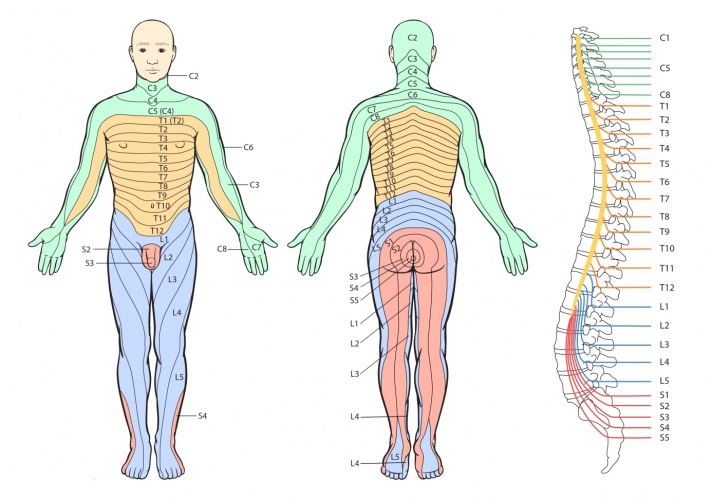Thoracic Radiculopathy: Difference between revisions
No edit summary |
No edit summary |
||
| (47 intermediate revisions by 6 users not shown) | |||
| Line 1: | Line 1: | ||
<div class="editorbox"> | |||
'''Original Editors ''' - [[User:Van der Hoeven Rik|Van der Hoeven Rik]], [[User:Henau Laurien|Henau Laurien]], [[User:Derick Glenn|Derick Glenn]] and [[User:Kafkot Nick|Kafkot Nick]] | |||
'''Original Editors ''' | |||
'''Top Contributors''' - {{Special:Contributors/{{FULLPAGENAME}}}} | '''Top Contributors''' - {{Special:Contributors/{{FULLPAGENAME}}}} | ||
</div> | </div> | ||
== Definition/Description == | == Definition/Description == | ||
[[File:Sam-burriss-zHSX9o2 B7Y-unsplash.jpg|right|frameless|375x375px]] | |||
Thoracic [[radiculopathy]] refers to a compressed nerve root in the [[Thoracic Anatomy|thoracic area]] of the spine. This is the least common location for radiculopathy. The symptoms often follow a [[Dermatomes|dermatomal]] distribution, and can cause pain and numbness that wraps around to the front of your body.. | |||
* The pinched nerve can occur at different areas along the thoracic spine | |||
* Symptoms of radiculopathy vary by location but frequently include pain, weakness, numbness and tingling. | |||
* A common cause of radiculopathy is narrowing of the space where nerve roots exit the spine, which can be a result of [[Spinal Stenosis|stenosis]], bone spurs, [[Thoracic Disc Syndrome|disc herniation]] or other conditions. | |||
* Radiculopathy symptoms can often be managed with nonsurgical treatments, but minimally invasive surgery can also help some patients. | |||
The most important structures which are involved with a [http://www.physio-pedia.com/Thoracic_radiculopathy thoracic radiculopathy] are the: | |||
* [[Thoracic Vertebrae|Thoracic vertebrae]] (T1-T12) | |||
* [[Intervertebral disc]] of the thoracic vertebrae, | |||
* 12 pairs of spinal nerve roots, | |||
* 12 rami - posterior rami innervate the regional muscles of the back, ventral rami innervate the skin and muscles of the chest and abdominal area.<ref name="p1">Thoracic radiculopathy, Ryan C. O’Connor et al., Physical & Medical Rehabilitation Clinics of North America, 2002 (evidence level 3B)</ref><br> | |||
=== Epidemiology /Etiology === | |||
Unknown, the diagnosis of thoracic radiculopathy is overlooked. | |||
[http://www.physio-pedia.com/Thoracic_radiculopathy Thoracic radiculopathy] has been infrequently reported and described as uncommon. | |||
[http://www.physio-pedia.com/Radiculopathy Radiculopathy] typically is a mechanical root compression , most commonly caused by: | |||
* [http://www.physio-pedia.com/Diabetes Diabetes mellitus] - 15% insulin-dependent and 13% non-insulin-dependent have diabetic thoracic polyradiculopathy.<ref name="p2">Non-Surgical Interventional Treatment of Cervical and Thoracic Radiculopathies, Pain Physician, Richard Derby, Yung Chen, Sang-Heon Lee, Kwan Sik Seo, and Byung-Jo Kim, Pain Physician, 2004 (evidence level 1A)</ref> | |||
* Degenerative spine changes such as [http://www.physio-pedia.com/Disc_Herniation disc herniation] and spondylosis. | |||
Other possible causes of mechanical root compression are a [http://www.physio-pedia.com/Skeletal_Metastases metastatic tumor], trauma, [http://www.physio-pedia.com/Scoliosis scoliosis], viral infection/inflammation, connective tissue disease and [http://www.physio-pedia.com/Tuberculosis tuberculosis]. | |||
== Characteristics/Clinical Presentation == | == Characteristics/Clinical Presentation == | ||
* A person may experience pain in the chest and torso when the nerve compression or irritation occurs in the mid back region. | |||
* Thoracic radiculopathy is an uncommon condition that may be misdiagnosed as shingles, heart, abdominal, or gallbladder complications. | |||
Symptoms associated with thoracic radiculopathy include: | |||
* Burning or shooting pain in the rib, side, or abdomennumbness and tingling | |||
[[File:INN.jpg|right|frameless|712x712px]] | |||
The symptoms of thoracic radiculopathy, regardless of the cause, are often not recognized, as there is typically no associated motor deficit. | |||
* When the etiology is disc herniation or trauma, motor deficit or myelopathy may be observed in the advanced stages. | |||
* The typical presentation of band-like thoracic or abdominal pain can mimic a myriad of conditions . | |||
* With many differential diagnoses to consider, it is not surprising that thoracic radiculopathy is often not discovered for months, or years, after symptoms arise<ref>Choi HE, Shin MH, Jo GY, Kim JY. [https://www.ncbi.nlm.nih.gov/pmc/articles/PMC4951374/ Thoracic radiculopathy due to rare causes.] Annals of rehabilitation medicine. 2016 Jun;40(3):534. Available from:https://www.ncbi.nlm.nih.gov/pmc/articles/PMC4951374/ (last accessed 25.4.2020)</ref> | |||
== Diagnosis == | |||
In addition to a physical exam and symptom review, doctors may diagnose radiculopathy using: | |||
* radiologic imaging with [[X-Rays|X-ra]]<nowiki/>y, [[MRI Scans|MRI]], and [[CT Scans|CT]] scans | |||
* electrical impulse testing called electromyography or EMG, to test nerve function | |||
* The exclusion of other causes of pain is the most important step in the diagnostic procedure as there are a lot of generators of thoracic pain and differentiating these differential diagnoses will be difficult<ref name="p1" /> | |||
Differential Diagnosis | |||
* Postherpetic [[Neuropathic Pain|neuralgia]] | |||
* Chronic abdominal wall pain | |||
*Spinal: Infectious, neoplastic (primary, metastatic), degenerative (spondylosis, spinal stenosis, facet syndrome, disc disease/HNP), metabolic (osteoporosis, osteomalacia), deformity (kyphosis, scoliosis, compression fracture, somatic dysfunction), neurogenic (radiculopathy, Herpes Zoster, anteriovenous malformation) | * Malignancy | ||
*Extraspinal: Intrathoracic (cardiovascular, pulmonary, mediastinal), Intra abdominal (Hepatobiliary, gastrointestinal, retroperitoneal), Musculoskeletal (Post-thoracotomy syndrome, polymyalgia rheumatica, myofascial pain syndrome, somatic dysfunction, rib fractures, costochondritis), Neurogenic (Intercostal neuralgia, peripheral polyneuropathy, RSD/ | * Other spinal disorders (e.g. spinal cord tumors, compression by intervertebral discs)<ref name="p7">The Clinical Anatomy and Management of Thoracic Spine Pain, L.G.F. Giles, 2000 (table 18.1 elements of the physical examination p 288) (evidence level 5)</ref> | ||
* Spinal: Infectious, neoplastic (primary, metastatic), degenerative (spondylosis, [http://www.physio-pedia.com/Spinal_Stenosis spinal stenosis], facet syndrome, [http://www.physio-pedia.com/Degenerative_Disc_Disease disc disease]/HNP), metabolic ([http://www.physio-pedia.com/Osteoporosis osteoporosis], osteomalacia), deformity ([http://www.physio-pedia.com/Kyphosis kyphosis], [http://www.physio-pedia.com/Scoliosis scoliosis], compression fracture, somatic dysfunction), neurogenic (radiculopathy, [http://www.physio-pedia.com/Herpes_Zoster Herpes Zoster], anteriovenous malformation) | |||
*Extraspinal: Intrathoracic (cardiovascular, pulmonary, mediastinal), Intra abdominal (Hepatobiliary, gastrointestinal, retroperitoneal), Musculoskeletal (Post-thoracotomy syndrome, [http://www.physio-pedia.com/Polymyalgia_Rheumatica polymyalgia rheumatica], myofascial pain syndrome, somatic dysfunction, [[Ribs|rib]] fractures, [[costochondritis]]), Neurogenic (Intercostal neuralgia, peripheral polyneuropathy, RSD/[http://www.physio-pedia.com/Complex_Regional_Pain_Syndrome_(CRPS) CRPS])<br> | |||
== Outcome Measures | === Outcome Measures === | ||
[[Visual Analogue Scale|VAS]] | |||
[[Oswestry Disability Index]].<ref name="p2" /> | |||
== Examination == | == Examination == | ||
Includes | |||
* Symptoms (already discussed earlier).<ref name="p3">Surgical Treatment of T1-2 Disc Herniation with T1 Radiculopathy: A Case Report with Review of the Literature, T1-2 Disc Herniation / 199, Eun-Seok Son et al., Asian Spine Journal, 2012 (evidence level 3A)</ref> | |||
* Due to non-universal tenderness and the sensory changes, it is not reliable to do a sensory examination. | |||
* Physical examination is not the best way to evaluate [http://www.physio-pedia.com/Thoracic_radiculopathy thoracic radiculopathy], unlike the lumbosacral and [http://www.physio-pedia.com/Cervical_Radiculopathy cervical radiculopathies] the affected muscles cannot be tested isolated. | |||
* The examination will rather be used to exclude other diagnoses then to determine a [http://www.physio-pedia.com/Thoracic_radiculopathy thoracic radiculopathy].<ref name="p1" /> | |||
Thus the examination will be done with more medical strategies and therefore we can use: EMG, MRI, CT, radiographs | |||
== Medical Management == | |||
* [[Pain Medications|non-steroidal drugs, such as ibuprofen, aspirin or naproxen]] | |||
== Medical Management | * [[Pain Medications|oral corticosteroids or injectable steroids]] | ||
* [[Pain Medications|narcotic pain medications]] | |||
* physical therapy | |||
* ice and heat application | |||
[[File:Brocnbells-com-team-o AKuNfcFyM-unsplash.jpg|right|frameless|450x450px]] | |||
== Physical Therapy Management | == Physical Therapy Management == | ||
Physical modalities of the therapy include: | |||
* [http://www.physio-pedia.com/Thermoherapy heat], | |||
* [http://www.physio-pedia.com/Ultrasound_therapy ultrasound] | |||
* [http://www.physio-pedia.com/Transcutaneous_Electrical_Nerve_Stimulation_(TENS) TENS]. | |||
* Spinal extension exercises..<ref name="p1" /> | |||
* Rest Education: avoid the activities that produce the pain (bending, lifting, twisting, turning, bending backwards, etc). | |||
* Apply ice in acute cases to the thoracic spine to help reduce pain and associated muscle spasm. | |||
* An [[Exercise Physiology|exercise]] regiment designed specifically to address the cause of the symptoms associated with pinched nerve and improve joint mobility, spinal alignment, posture, and range of motion. | |||
* Restore joint function ( eg [[Thoracic Manual Techniques and Exercises|Spinal manipulations or mobilisations]]<ref name="p6">T2 radiculopathy: A differential screen for upper extremity radicular pain. Sebastian D., Physiotherapy Theory and Practice, 2013 (evidence level 3B)</ref>) | |||
* Improve motion | |||
* Help the return of full function. | |||
== | === Clinical Bottom Line === | ||
Mild Cases | |||
* In mild cases many patients found that rest, ice and medication were enough to reduce the pain. Physical therapy is recommended to develop a series of postural, stretching and strengthening exercises to prevent re-occurrence of the injury. Return to activity should be gradual to prevent a return of symptoms. | |||
Moderate to Severe Cases | |||
* If the problem consultation with your health care provider. Your physician should perform a thorough evaluation to determine the possible cause of your symptoms, the structures involved, the severity of the condition, and the best course of treatment.<ref>Redefine HC [https://redefinehealthcare.com/thoracic-radiculopathy/ Thoracic radiculopathy] Available from:https://redefinehealthcare.com/thoracic-radiculopathy/ (last accessed 25.4.2020)</ref> | |||
== References == | |||
== References | |||
<references />> | <references />> | ||
| Line 84: | Line 98: | ||
<br> | <br> | ||
[[Category:Vrije_Universiteit_Brussel_Project | [[Category:Vrije_Universiteit_Brussel_Project]] | ||
[[Category:Neuropathy]] | |||
[[Category:Conditions]] | |||
[[Category:Thoracic Spine]] | |||
[[Category:Thoracic Spine - Conditions]] | |||
Latest revision as of 12:41, 25 April 2020
Original Editors - Van der Hoeven Rik, Henau Laurien, Derick Glenn and Kafkot Nick
Top Contributors - Haegeman Nicolas, Rik Van der Hoeven, Kim Jackson, Lucinda hampton, 127.0.0.1, Admin, WikiSysop and Amanda Ager
Definition/Description[edit | edit source]
Thoracic radiculopathy refers to a compressed nerve root in the thoracic area of the spine. This is the least common location for radiculopathy. The symptoms often follow a dermatomal distribution, and can cause pain and numbness that wraps around to the front of your body..
- The pinched nerve can occur at different areas along the thoracic spine
- Symptoms of radiculopathy vary by location but frequently include pain, weakness, numbness and tingling.
- A common cause of radiculopathy is narrowing of the space where nerve roots exit the spine, which can be a result of stenosis, bone spurs, disc herniation or other conditions.
- Radiculopathy symptoms can often be managed with nonsurgical treatments, but minimally invasive surgery can also help some patients.
The most important structures which are involved with a thoracic radiculopathy are the:
- Thoracic vertebrae (T1-T12)
- Intervertebral disc of the thoracic vertebrae,
- 12 pairs of spinal nerve roots,
- 12 rami - posterior rami innervate the regional muscles of the back, ventral rami innervate the skin and muscles of the chest and abdominal area.[1]
Epidemiology /Etiology[edit | edit source]
Unknown, the diagnosis of thoracic radiculopathy is overlooked.
Thoracic radiculopathy has been infrequently reported and described as uncommon.
Radiculopathy typically is a mechanical root compression , most commonly caused by:
- Diabetes mellitus - 15% insulin-dependent and 13% non-insulin-dependent have diabetic thoracic polyradiculopathy.[2]
- Degenerative spine changes such as disc herniation and spondylosis.
Other possible causes of mechanical root compression are a metastatic tumor, trauma, scoliosis, viral infection/inflammation, connective tissue disease and tuberculosis.
Characteristics/Clinical Presentation[edit | edit source]
- A person may experience pain in the chest and torso when the nerve compression or irritation occurs in the mid back region.
- Thoracic radiculopathy is an uncommon condition that may be misdiagnosed as shingles, heart, abdominal, or gallbladder complications.
Symptoms associated with thoracic radiculopathy include:
- Burning or shooting pain in the rib, side, or abdomennumbness and tingling
The symptoms of thoracic radiculopathy, regardless of the cause, are often not recognized, as there is typically no associated motor deficit.
- When the etiology is disc herniation or trauma, motor deficit or myelopathy may be observed in the advanced stages.
- The typical presentation of band-like thoracic or abdominal pain can mimic a myriad of conditions .
- With many differential diagnoses to consider, it is not surprising that thoracic radiculopathy is often not discovered for months, or years, after symptoms arise[3]
Diagnosis[edit | edit source]
In addition to a physical exam and symptom review, doctors may diagnose radiculopathy using:
- radiologic imaging with X-ray, MRI, and CT scans
- electrical impulse testing called electromyography or EMG, to test nerve function
- The exclusion of other causes of pain is the most important step in the diagnostic procedure as there are a lot of generators of thoracic pain and differentiating these differential diagnoses will be difficult[1]
Differential Diagnosis
- Postherpetic neuralgia
- Chronic abdominal wall pain
- Malignancy
- Other spinal disorders (e.g. spinal cord tumors, compression by intervertebral discs)[4]
- Spinal: Infectious, neoplastic (primary, metastatic), degenerative (spondylosis, spinal stenosis, facet syndrome, disc disease/HNP), metabolic (osteoporosis, osteomalacia), deformity (kyphosis, scoliosis, compression fracture, somatic dysfunction), neurogenic (radiculopathy, Herpes Zoster, anteriovenous malformation)
- Extraspinal: Intrathoracic (cardiovascular, pulmonary, mediastinal), Intra abdominal (Hepatobiliary, gastrointestinal, retroperitoneal), Musculoskeletal (Post-thoracotomy syndrome, polymyalgia rheumatica, myofascial pain syndrome, somatic dysfunction, rib fractures, costochondritis), Neurogenic (Intercostal neuralgia, peripheral polyneuropathy, RSD/CRPS)
Outcome Measures[edit | edit source]
Examination[edit | edit source]
Includes
- Symptoms (already discussed earlier).[5]
- Due to non-universal tenderness and the sensory changes, it is not reliable to do a sensory examination.
- Physical examination is not the best way to evaluate thoracic radiculopathy, unlike the lumbosacral and cervical radiculopathies the affected muscles cannot be tested isolated.
- The examination will rather be used to exclude other diagnoses then to determine a thoracic radiculopathy.[1]
Thus the examination will be done with more medical strategies and therefore we can use: EMG, MRI, CT, radiographs
Medical Management[edit | edit source]
- non-steroidal drugs, such as ibuprofen, aspirin or naproxen
- oral corticosteroids or injectable steroids
- narcotic pain medications
- physical therapy
- ice and heat application
Physical Therapy Management[edit | edit source]
Physical modalities of the therapy include:
- heat,
- ultrasound
- TENS.
- Spinal extension exercises..[1]
- Rest Education: avoid the activities that produce the pain (bending, lifting, twisting, turning, bending backwards, etc).
- Apply ice in acute cases to the thoracic spine to help reduce pain and associated muscle spasm.
- An exercise regiment designed specifically to address the cause of the symptoms associated with pinched nerve and improve joint mobility, spinal alignment, posture, and range of motion.
- Restore joint function ( eg Spinal manipulations or mobilisations[6])
- Improve motion
- Help the return of full function.
Clinical Bottom Line[edit | edit source]
Mild Cases
- In mild cases many patients found that rest, ice and medication were enough to reduce the pain. Physical therapy is recommended to develop a series of postural, stretching and strengthening exercises to prevent re-occurrence of the injury. Return to activity should be gradual to prevent a return of symptoms.
Moderate to Severe Cases
- If the problem consultation with your health care provider. Your physician should perform a thorough evaluation to determine the possible cause of your symptoms, the structures involved, the severity of the condition, and the best course of treatment.[7]
References[edit | edit source]
- ↑ 1.0 1.1 1.2 1.3 Thoracic radiculopathy, Ryan C. O’Connor et al., Physical & Medical Rehabilitation Clinics of North America, 2002 (evidence level 3B)
- ↑ 2.0 2.1 Non-Surgical Interventional Treatment of Cervical and Thoracic Radiculopathies, Pain Physician, Richard Derby, Yung Chen, Sang-Heon Lee, Kwan Sik Seo, and Byung-Jo Kim, Pain Physician, 2004 (evidence level 1A)
- ↑ Choi HE, Shin MH, Jo GY, Kim JY. Thoracic radiculopathy due to rare causes. Annals of rehabilitation medicine. 2016 Jun;40(3):534. Available from:https://www.ncbi.nlm.nih.gov/pmc/articles/PMC4951374/ (last accessed 25.4.2020)
- ↑ The Clinical Anatomy and Management of Thoracic Spine Pain, L.G.F. Giles, 2000 (table 18.1 elements of the physical examination p 288) (evidence level 5)
- ↑ Surgical Treatment of T1-2 Disc Herniation with T1 Radiculopathy: A Case Report with Review of the Literature, T1-2 Disc Herniation / 199, Eun-Seok Son et al., Asian Spine Journal, 2012 (evidence level 3A)
- ↑ T2 radiculopathy: A differential screen for upper extremity radicular pain. Sebastian D., Physiotherapy Theory and Practice, 2013 (evidence level 3B)
- ↑ Redefine HC Thoracic radiculopathy Available from:https://redefinehealthcare.com/thoracic-radiculopathy/ (last accessed 25.4.2020)
>









